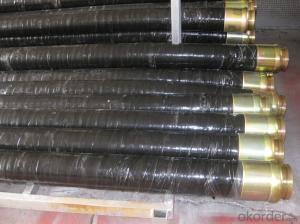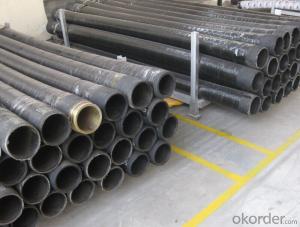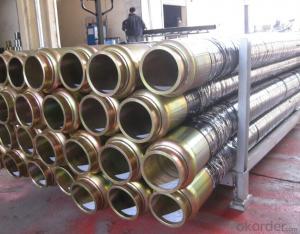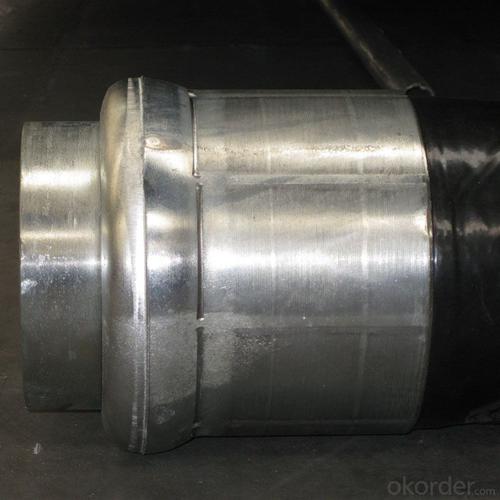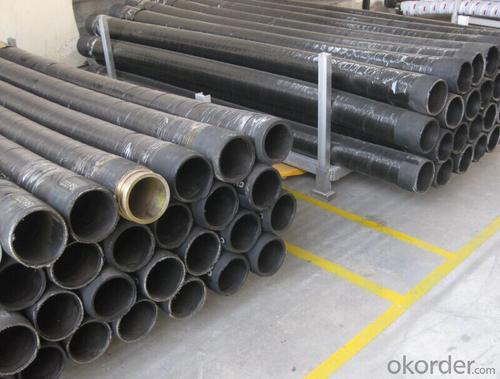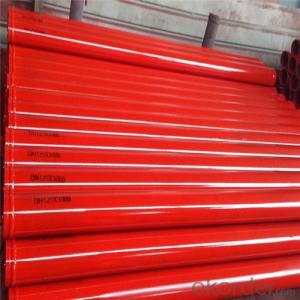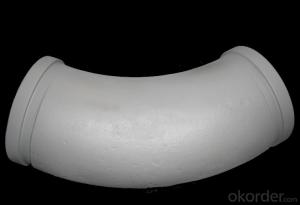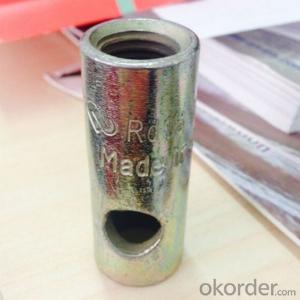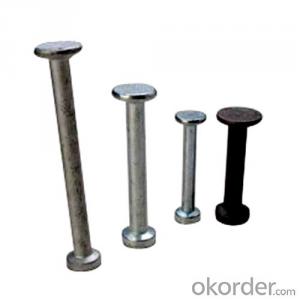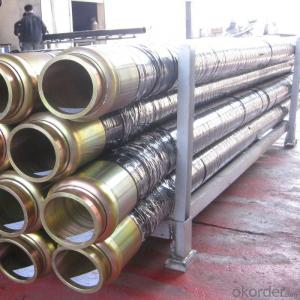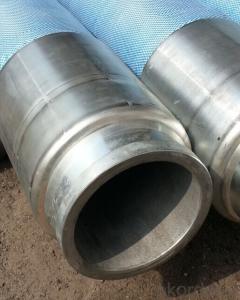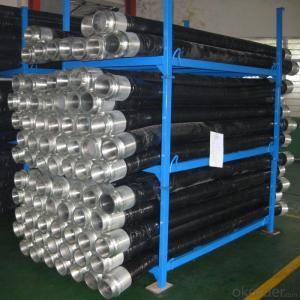Rubber End Hose with Two Side Couplings Working Pressure 85 Bar 3M*DN75
- Loading Port:
- Shanghai
- Payment Terms:
- TT OR LC
- Min Order Qty:
- 10 pc
- Supply Capability:
- 5000 pc/month
OKorder Service Pledge
OKorder Financial Service
You Might Also Like
Product Description:
The 3M*DN75 rubber end hose with two side couplings, normally the hoes is made by NR and reinforced by four layer steel wire, and the two couplings at each side are made by steel material No.ST52, 20#, 37MN5, with hot treatment according to customer’s requests, and also package in bundles or nude packing directly put into container.
Scope of Application of the hose
The 3M*DN75 rubber end hose is a concrete delivery for combined use with other concrete pipelines in concrete placement operations. It can be widely used in the construction of various types of concrete structures like industrial and civil buildings, bridges, roads, and other types of infrastructure.
Product Advantages:
OKorder's 3M*DN75 rubber end hose Channels are durable, strong, and safety. We are the biggest group in this business filed and the majority resources are under our control, which is make sure the delivery time and qualified products, meanwhile we have more than 20 overseas branches our people will go to visit customer very fast for more convenient communication.
Main Product Features:
High safety.
· Professional Service
· Competitive pricing
Measuring of wall thickness from the outside
Low purchase cost
FAQ:
Q1: How do we guarantee the quality of our products?
A1: We have established an advanced quality management system which conducts strict quality tests at every step, from raw materials to the final product. At the same time, we provide extensive follow-up service assurances as required.
Q2: How soon can we receive the product after purchase?
A2: Within three days of placing an order, we will book the vessel for goods. The specific shipping date is dependent upon international and government factors, but is typically 7 to 30 workdays.
Q3: If we can produce some pipes according to customers request?
A3: Yes, we can produce Concrete Placing Boom according to the difference country situations to make it suitable to the market and customers. We have very professional technical team to make the design.
Name | Concrete Pump Rubber Hose | |||||
Size | ID | OD | Number of layer | Work pressure | bursting pressure | weight |
3.5" | 113 | 2 | 1200psl | 3000psl | 6.8kg/m | |
4" | 128 | 2 | 1200psl | 3000psl | 7.8kg/m | |
5" | 154 | 2 | 1200psl | 3000psl | 10kg/m | |
5" | 154 | 4 | 1200psl | 3000psl | 12kg/m | |
6" | 181 | 2 | 1200psl | 3000psl | 15kg/m | |
Other size and types upon request | ||||||
Usual Size | 4"-DN80, 5" -DN125, 6"-DN150 | |||||
Material | natrual rubber,steel wire | |||||
Technic | steel wire weaving,composite molding | |||||
Application | used in concrete transport of concrete pump end in construction work | |||||
Serving Brands Of Mounted Truck Concrete Pump And Concrete Pump | SANY,Zoomlion,PM,CIFA and so on | |||||
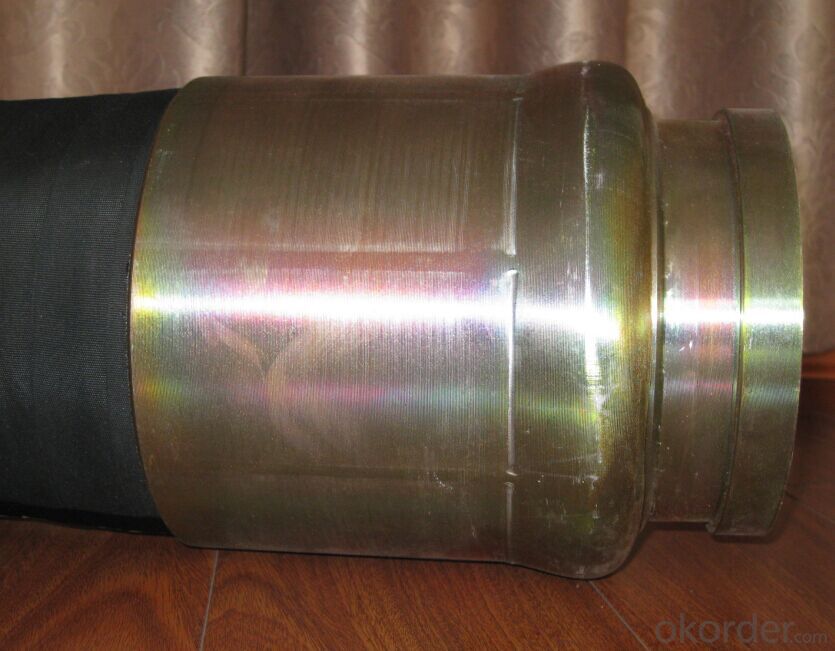

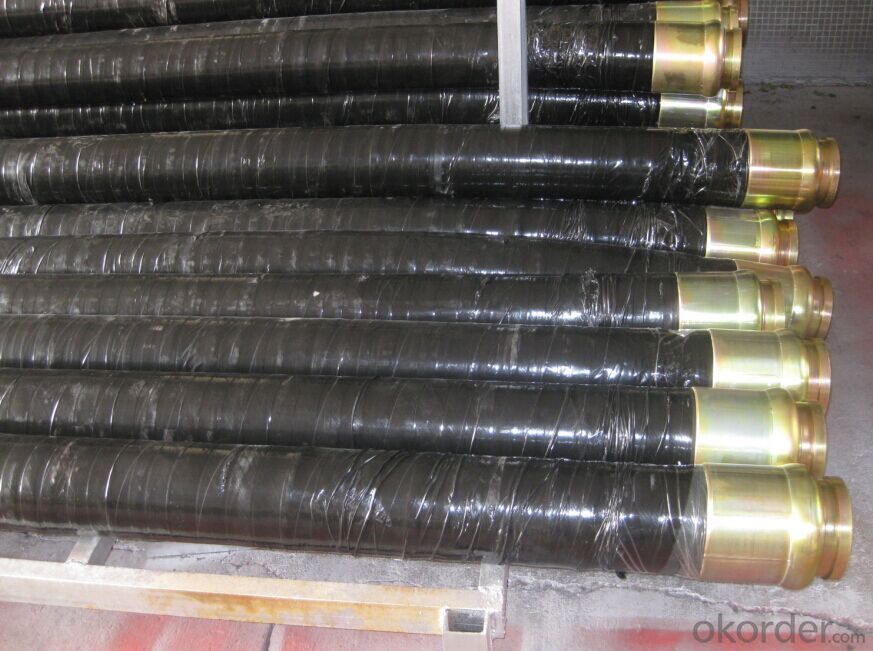
- Q: Can I get spare parts for concrete pump hydraulic cylinders and valves?
- Absolutely, spare parts for concrete pump hydraulic cylinders and valves are readily available. There is a wide range of companies and suppliers dedicated to supplying spare parts specifically for construction machinery, such as hydraulic cylinders and valves for concrete pumps. These spare parts can be conveniently obtained online or through nearby distributors. To ensure compatibility and proper operation of the spare parts, it is crucial to provide precise details about the make and model of your concrete pump. Furthermore, it is recommended to select reputable suppliers who offer authentic, top-notch spare parts for optimal performance and longevity.
- Q: Are there any maintenance tips to extend the lifespan of concrete pump spare parts?
- Yes, there are several maintenance tips that can help extend the lifespan of concrete pump spare parts. 1. Regular Cleaning: It is important to regularly clean the spare parts to remove any dirt, debris, or concrete buildup. This can be done using a brush, water, and mild detergent. Cleaning helps prevent corrosion and ensures smooth operation. 2. Lubrication: Proper lubrication of moving parts is crucial to reduce friction and wear. It is important to follow the manufacturer's recommendations for lubrication intervals and use high-quality lubricants. Regularly inspect the lubrication points and replace any worn-out or damaged lubrication components. 3. Inspections and Maintenance: Regular inspections of all spare parts are necessary to identify any signs of wear, damage, or misalignment. Any issues should be repaired or replaced promptly. Additionally, following the maintenance schedule provided by the manufacturer is essential to address any potential problems before they escalate. 4. Proper Storage: When not in use, spare parts should be stored in a clean and dry environment to prevent rust and corrosion. They should be protected from extreme temperatures, moisture, and direct sunlight. Additionally, spare parts should be stored in a way that prevents any damage or deformation. 5. Correct Usage: It is crucial to operate the concrete pump in accordance with the manufacturer's guidelines. Overloading, excessive pressure, or improper operation can lead to premature wear and damage to the spare parts. Proper training should be provided to the operators to ensure they understand the correct usage techniques. 6. Regular Maintenance of the Concrete Pump: The overall condition of the concrete pump can have an impact on the lifespan of the spare parts. Regular maintenance of the pump, including cleaning, lubrication, and inspections, can help identify and address any potential issues that may affect the spare parts. By following these maintenance tips, the lifespan of concrete pump spare parts can be extended, reducing the need for frequent replacements and saving costs in the long run.
- Q: How often should concrete pump hydraulic oil coolers be inspected and maintained?
- To guarantee optimal performance and avoid possible problems, it is necessary to carry out regular inspections and maintenance on the hydraulic oil coolers of concrete pumps. The frequency of these procedures will vary depending on factors such as the pump's operating conditions, workload, and the recommendations provided by the manufacturer. As a general rule, it is advisable to inspect and maintain the concrete pump hydraulic oil coolers at least once every six months or every 500-700 operating hours, whichever comes first. However, in more demanding or extreme operating conditions, it may be necessary to perform these tasks more frequently. During these inspections, it is of utmost importance to thoroughly clean the cooler and examine it for any signs of damage, corrosion, or leaks. It is also crucial to inspect the cooler's fins for any blockages, as the presence of debris or dirt can decrease its efficiency. Regularly checking and replacing the air filters of the cooler is equally important to ensure proper airflow and prevent overheating. In terms of regular maintenance, it is vital to replace the hydraulic oil and filters according to the manufacturer's recommendations. This action helps maintain the oil's viscosity and prevents any contaminants from causing damage to the cooler or other hydraulic components. To summarize, conducting regular inspections and maintenance on concrete pump hydraulic oil coolers is crucial to ensure efficient operation and prolong their lifespan. By adhering to the manufacturer's guidelines and taking into account specific operating conditions, it is possible to determine the appropriate frequency for these inspections and maintenance tasks.
- Q: Are there any specific guidelines for the disposal of packaging materials of concrete pump spare parts?
- Yes, there are specific guidelines for the disposal of packaging materials of concrete pump spare parts. It is recommended to follow local regulations and environmental guidelines to ensure proper disposal. This may include recycling or reusing packaging materials whenever possible and disposing of them in designated waste management facilities.
- Q: What are the indications of a damaged concrete pump boom?
- There are several indications that can point to a damaged concrete pump boom. These indications can include: 1. Visual damage: One of the most obvious signs of a damaged concrete pump boom is visible physical damage. This can include cracks, dents, or deformities in the boom structure. Any signs of structural damage should be taken seriously as they can compromise the integrity of the boom. 2. Leaks: Another indication of a damaged boom is the presence of leaks. If you notice hydraulic fluid or water leaking from the boom, it could be a sign of a damaged hose or fitting. Leaks can not only affect the performance of the pump but also pose a safety risk to the operator and those working around the equipment. 3. Misalignment: A damaged boom may also exhibit misalignment issues. If the boom is not straight or appears to be bent at an odd angle, it could indicate damage. Misalignment can affect the accuracy and efficiency of concrete placement, potentially leading to uneven or improper pouring. 4. Unusual noises: Strange or excessive noises during operation can be a sign of a damaged boom. Rattling, grinding, or squealing sounds can indicate loose or worn-out components, such as pins, bushings, or bearings. These noises should not be ignored, as they could worsen if not addressed promptly. 5. Reduced performance: A damaged boom may also result in reduced performance. If you notice a decrease in pumping capacity or difficulties in controlling the boom's movement, it could be an indication of damage. Poor performance can be caused by various issues, including hydraulic system problems, structural damage, or worn-out parts. In conclusion, it is crucial to regularly inspect and maintain concrete pump booms to identify any indications of damage. Promptly addressing these issues is essential to ensure the safety of operators, prevent further damage, and maintain the efficiency and performance of the equipment.
- Q: How does a hopper vibrator prevent concrete blockages?
- A hopper vibrator is a mechanical device designed to prevent concrete blockages in construction equipment, such as concrete pumps and mixers. It works by applying vibrations to the hopper, which is the large container where the concrete is stored before it is poured or transferred. The main reason concrete blockages occur is due to the tendency of the material to settle and become compacted, especially when it is stored for a long time or during transportation. This can lead to clogging and obstruction of the flow of concrete, slowing down the construction process and potentially causing damage to the equipment. By using a hopper vibrator, the vibrations are transmitted to the concrete within the hopper, effectively preventing it from settling and compacting. The vibrations create a loosening effect on the concrete particles, ensuring that they remain in a more fluid state. This allows for a continuous and smooth flow of concrete, preventing any blockages or obstructions from occurring. Additionally, the vibrations from the hopper vibrator also help to dislodge any potential blockages that may have already formed. The shaking motion can break up clumps of concrete or other debris that might be blocking the flow, allowing for uninterrupted movement of the material. Overall, a hopper vibrator is an essential tool in construction equipment as it helps to maintain a consistent flow of concrete, preventing blockages and ensuring the smooth and efficient operation of the construction process.
- Q: How can the concrete pump be installed and used?
- Evacuate the surrounding area while dredging the pipe. Remove pipe before cleaning should be taken to counter method, clear pipeline pressure. The pipe mouth is not allowed to disassemble
- Q: What are the different types of concrete pump hopper agitator motors?
- There are generally two types of concrete pump hopper agitator motors: electric motors and hydraulic motors. Electric motors are powered by electricity and are commonly used in smaller and portable concrete pumps. Hydraulic motors, on the other hand, are driven by hydraulic power generated by the concrete pump itself and are typically used in larger and stationary concrete pumps.
- Q: Are there any specific guidelines for the installation of control panels or electronic components in concrete pump spare parts?
- Specific guidelines exist for the installation of control panels or electronic components in concrete pump spare parts. When installing such components, it is important to consider the following guidelines: 1. Protection from Moisture: Electronic components can be damaged by moisture, so it is advisable to install them in waterproof or moisture-resistant enclosures to prevent damage from water or humidity. 2. Vibration and Shock Absorption: To avoid damage, it is recommended to use shock-absorbing mounts or vibration-resistant enclosures to minimize the impact of vibration and shock on control panels or electronic components. 3. Temperature Control: Extreme temperatures can affect concrete pump spare parts, so it is crucial to install control panels or electronic components in a temperature-controlled environment. This may involve using insulation or cooling systems to maintain a suitable operating temperature. 4. Wiring and Connections: Proper wiring and connections are essential for the functioning of control panels or electronic components. It is important to follow the manufacturer's instructions and guidelines for wiring, ensuring secure connections and providing adequate insulation and protection against short circuits or electrical hazards. 5. Accessibility and Maintenance: Control panels or electronic components should be installed in a way that allows easy access for maintenance and repairs. Sufficient space should be left around the components for easy inspection, servicing, and replacement if needed. By adhering to these guidelines, the installation of control panels or electronic components in concrete pump spare parts can be carried out to ensure their long-term functionality and durability.
- Q: Are there any online resources or manuals available for concrete pump spare parts?
- Indeed, the online realm offers a plethora of resources and manuals for concrete pump spare parts. Numerous manufacturers and suppliers of such components have established their own websites, which furnish comprehensive details concerning their products, encompassing manuals, catalogs, and technical specifications. It is worth noting that these websites often dedicate sections or pages specifically for spare parts, facilitating the acquisition of information pertaining to diverse types of spare parts, their compatibility with various pump models, and the process of ordering them. In addition to the aforementioned manufacturer websites, there exists a profusion of online marketplaces and directories that specialize in construction equipment and spare parts. These platforms empower users to conduct targeted searches for concrete pump spare parts, enabling the comparison of prices and specifications provided by different suppliers. Furthermore, some of these platforms offer supplementary resources, including user reviews, ratings, and guides to assist in selecting the appropriate spare parts for a given pump model. Moreover, online forums and communities cater to professionals in the construction industry, furnishing platforms for the exchange of information and discussions concerning concrete pumps and their spare parts. These forums serve as invaluable resources for obtaining recommendations, resolving common issues, and connecting with experts capable of offering guidance on sourcing and maintaining spare parts for concrete pumps. Overall, regardless of whether one is a concrete pump operator, maintenance technician, or an individual seeking spare parts for a concrete pump, the online domain abounds with resources that can provide the necessary information and manuals.
Send your message to us
Rubber End Hose with Two Side Couplings Working Pressure 85 Bar 3M*DN75
- Loading Port:
- Shanghai
- Payment Terms:
- TT OR LC
- Min Order Qty:
- 10 pc
- Supply Capability:
- 5000 pc/month
OKorder Service Pledge
OKorder Financial Service
Similar products
Hot products
Hot Searches
Related keywords

